Homemade Flatbread {Greek Pocketless Pitas with a Simple Tutorial}
Get this recipe for simple and delicious homemade flatbread! With a step-by-step tutorial, it’s easier than you think!
Flatbread is yummy. Soft, fluffy homemade flatbread is even yummier.
If you are wondering why on earth you would ever want to make your own flatbread, I have two words for you: Chicken Gyros.
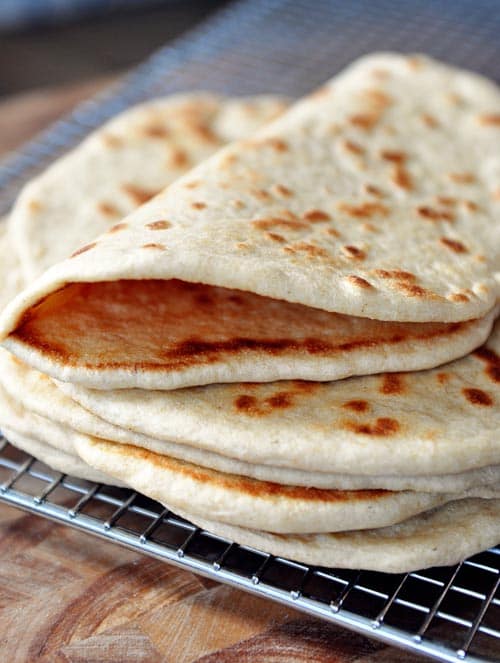
And wait!
Four more: Big Fat Greek Tacos. And how about? Simple Pita Pizzas.
The truth is, I could bombard you with a hundred more words that sum up why flatbread needs to be part of your life but I won’t (phew!).
Basically, this flatbread is extremely versatile; you could use it in so many different ways and it is really simple to make.
Those of you who have seen or made the soft wrap bread (that I adore) and/or this lovely naan bread (which I also adore) may want to know how this current flatbread differs.
It’s slightly thinner and a bit softer than the naan (so it bends easier) and has a completely different taste than the soft wrap bread (since the soft wrap bread has a potato base).
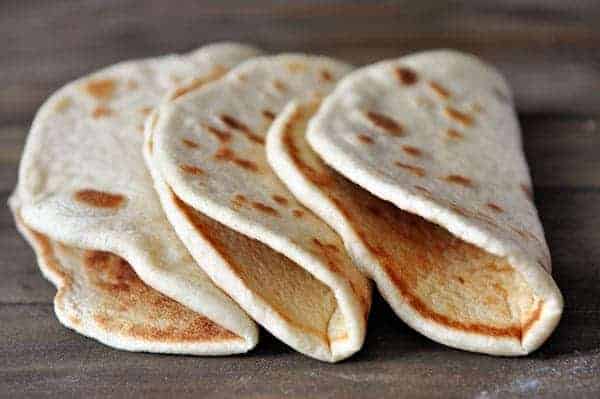
I think the moral of this story, though, is you can never have too many flatbread recipes in your recipe notebook.
Right? Right.
I included a few simple step-by-step photos of rolling and cooking the flatbread. Once you see it, you’ll realize how easy it is.
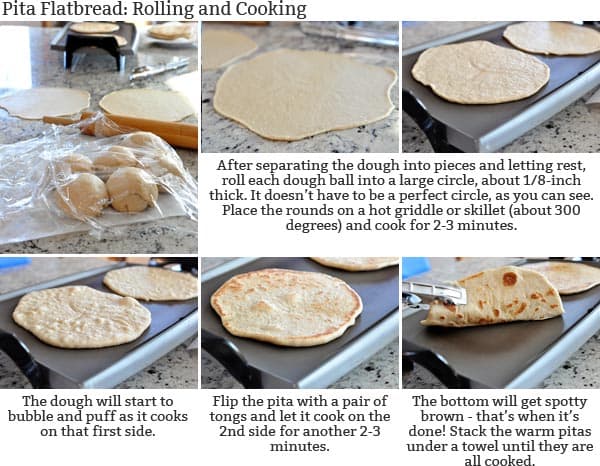
I always double or triple this batch, fire up the griddle and cook my heart out so I can freeze these babies to pull out at a moment’s notice.
We really do capitalize on the simple pita pizza thing (throw it under the broiler with all the toppings for a minute or so and you are good to go) as well as rolling up our favorite sandwich fixings for lunch.
Flatbread! It’s a really good thing.
One Year Ago: Hard-Boiled Eggs: A No-Fail Method
Two Years Ago: DIY Dulce de Leche
Three Years Ago: New Momma Take-In Tray
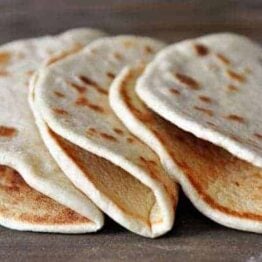
Homemade Flatbread {Greek Pocketless Pitas}
Ingredients
- 2 teaspoons instant yeast
- 1 teaspoon granulated sugar
- ⅔ cup warm water, about 100 degrees, warm but not hot to the touch
- ½ cup warm milk, about 100 degrees, warm but not hot to the touch
- 1 tablespoon extra-virgin olive oil
- 1 teaspoon salt
- 3 cups (426 g) bread flour, more or less (see note)
Instructions
- In a large bowl (or bowl of an electric stand mixer fitted with the dough hook), mix the yeast, sugar water, milk, oil, salt and one cup of the flour until well combined.
- Gradually add the remaining flour until a soft dough is formed. It will pull away from the sides of the bowl to form a ball but still be slightly soft to the touch (see the note). Knead the dough for 4-5 minutes until it is soft and smooth.
- Place the dough in a lightly greased bowl and cover with greased plastic wrap; let rise until doubled, about an hour or so.
- Divide the dough into six or eight equal pieces. Cover with a cloth or plastic wrap and let the dough pieces rest for 10-15 minutes (this helps relax the gluten so they are easier to roll out).
- Working with one piece at a time, on a lightly greased or floured counter, roll the dough about 1/8-inch thick into a large circle, about 7-8 inches in diameter.
- Heat a griddle or skillet to medium heat (I preheat my electric griddle to 300 degrees). When the griddle/skillet is hot, cook the flatbread for 2-3 minutes on the first side until it bubbles and puffs. Flip it over with a pair of tongs and cook on the second side until it is golden and spotty. If the skillet isn’t hot enough, the bread can turn out dry (and won’t bend easily) from being overcooked so look for the right amount of heat that will cook the flatbread in 2-3 minutes max per side.
- Transfer the flatbread to a plate or work surface and cover with a clean kitchen towel. Repeat with the remaining dough (I can fit two pieces of flatbread on my electric griddle so I roll out two at a time), stacking each warm flatbread on top of the others and covering with the towel.
- The flatbread can be made, cooked, cooled and frozen with great results. It is best served the day it is made but can be reheated gently the day after, if needed.
Notes
Recommended Products
Recipe Source: adapted from Jaclyn at Cooking Classy (reduced sugar, oil and salt, used instant yeast and adapted bread flour amounts, as well as adapting the method a bit)

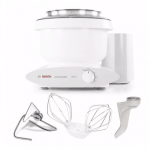
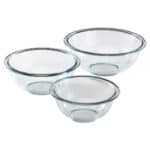
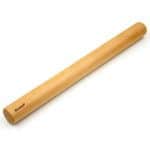
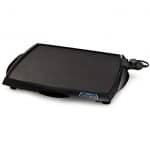
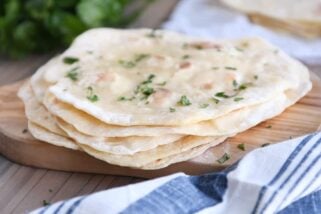
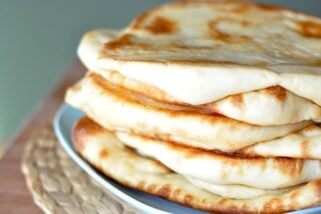
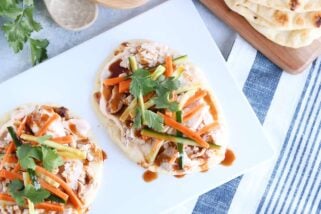
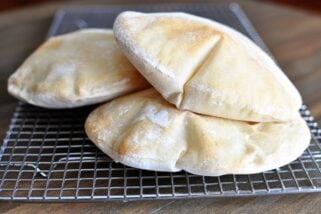
Hi Mel!
My family really likes this flatbread! I made them with your Big Fat Greek Tacos. I do need some advice though. I let the dough rest and they rolled out quite well, but when I transferred them to the gridle , they shrunk in size. Do you have any tips on how I can prevent this from happening?
Hi Becky, it’s normal for the dough to shrink a bit when baking, so I think it’s probably fine! You can mitigate that by rolling the dough bigger anticipating they’ll shrink. Also, letting them rest a bit longer before cooking can help relax the gluten and shrink less.
Just made these to eat with Corn Chowder. They are delicious! Followed recipe exactly. Thanks for this.
Mel never disappoints! I wanted to attempt pitas for the first time and after looking thru some tiktoks and other googled recipes, decided to see if she had a recipe- sure enough, she did! This recipe was simple, the instructions were clear and informative (I appreciate the explanation about resting the gluten to allow for easier rolling- I wonder if that’s where I’ve been going wrong with my tortilla attempts).
The dough was soft and well balanced in taste, and created a nice pita pocket. We filled ours with chicken, cucumber, pickled onion, tomatoes, and tzatziki sauce. So good!
I had been looking for a recipe to make flour tortillas and this recipe works great and has a great flavor. I used half the recipe to make smaller tortilla for tacos and this recipe is a keeper. It will also be great for burritos and flatbreads. Thank you for sharing the recipe.
great and easy recipe!
We love this recipe!
I also want to say that I always freeze the bread in a freezer ziploc bag the same day to keep them fresh. I take out what I’m using and cook in the microwave for a few seconds to thaw them or I thaw them on the counter.
I love this bread recipe. I have been making this recipe for about 10 years! Everyone seems to enjoy this bread. I’ve given out your recipe. Thank you!
YUM! These are so good! Mine wouldn’t brown like the picture, and they kept shrinking after I rolled them out when I peeled them up to cook them….but they were delicious!
The flatbread pitas are something I simply got tempted with at the very first bite. I tied out this one with meat curry and the combination was a match made in heaven.
So easy and so delicious!! I’ll never do store bought flatbread again now that I have this recipe in my arsenal. Made pita pizzas with the leftover bread using muhammara and leftover grilled chicken – fantastic!! Thank you for sharing this!
I was worried these might be tough because my dough wasn’t sticky and I only used some of the projected amount of flour. Nope. They were perfect. I will probably make them smaller next time, because I can’t eat a dinner plate sized sandwich. But the flavor and texture were lovely and I’m grateful for the recipe. Btw, I used all purpose and had no issues.
I was worried these might be tough because my dough wasn’t sticky and I only used some of the projected amount of flour. Nope. They were perfect. I will probably make them smaller next time, because I can’t eat a dinner plate sized sandwich. But the flavor and texture were lovely and I’m grateful for the recipe. Btw, I used all purpose and had no issues.
These are amazing! My 5-year old helped to shape them and roll them out. With the extra fuss I worried they might be tough, but they were soft and perfect! I used your chicken gyros recipe for the chicken, too. They were every bit as good as what we used to get from the gyro places in Boise! Thank you!
Another great recipe! Thank you! Always get compliments whenever I make these wonderful flat bread.
You mentioned that you like to make a bunch so you can freeze some and have it on hand whenever you want it. Does it freeze well and do you just toast or microwave it after thawing?
Thank you!
Yes it freezes great!
Delicious. Plan plenty of extra time for rolling and cooking.
Hi Mel! Have you ever cooked these on the grill? Just wondering because one of our favorite dinners EVER is a salad pizza with a grilled crust.
I haven’t, but I’ve grilled pizza dough and it works great…so I bet these would cook up well on a grill, too!
Made this last night and I was impressed. The dough is a dream to work with and the finished product was exactly what I wanted for the grilled kenbabs I made.
The only difference I had was I used the Breville countertop pizza oven so I had to dock the shaped dough so it wouldn’t puff up.
Thank you fo a wonderful recipe.
I made this, and the naan bread to go with it, completely dairy and egg free and it was amazing! I subbed vegan mayo and oat milk for milk in the bread. My entire family gobbled it up! Thanks Mel!
Fabulous flatbread recipe! After trying other pretty good ones, this is the best!
I’ve never used bread flour per se, but I did have 00 Flour, which is technically a bread flour. Results were fantastic.
I love your Flour Rule for yeast breads. After making breads that require kneading a few times (I’ve only picked up bread making again in the last year), I have learned that a slightly sticky mix that JUST forms a dough ball is ready for kneading. I required another 1/2 cup flour to get it soft, smooth and ready for rise, and I now live in the Deep South………So, everyone is going to have a different experience. Don’t despair. Bread making for me has changed drastically over the years having lived in 3 vastly different climates.
Anyway, the flatbreads were perfectly crispy on the grill spots, and wonderfully pliable, soft and chewy otherwise.
very good
This flat bread is THE SHIT!!!
AMAZING RECIPE!!
I’m from Germany and used to live down the street from a small Greek restaurant. I ate a pita gyro sandwich at least twice a week. When I came to the U.S. and had a gyro sandwich here, the pita bread just wasn’t the same. Even at “authentic” Greek restaurants. So when I tried your recipe, I wasn’t expecting much. Just wanted to see how they would turn out. Well, they turned out AMAZING. Just like the ones I used to eat back in Germany. I found a recipe for authentic gyro spice mix and tzatziki sauce, and made gyro sandwiches for dinner tonight. They were a hit.
Thank you so much for posting this recipe. I immediately bookmarked it and will do pita bread again before too long. Probably gonna make enough to fill up my freezer
Thanks again!!
Great recipe! I followed it exactly, and the flatbread was amazing. Definitely adding to my list of go-to recipes.
Hi.
Just a little confused.
The recipe says to knead for 4-5minutes, but the information on yeast says to knead the dough for eight minutes.
Can you help me please?
Lori
Hi Lori, 4-5 minutes is enough kneading time for this recipe.
Hi Mel,
I can’t wait to give these a try! I love pitas, but I’m trying to stay away from processed food. These will be perfect for at-home lunches. Thanks so much for sharing!
I wonder if this flatbread would be good for making pita chips?